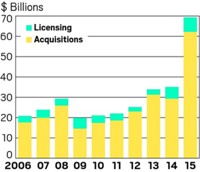Advertisement
Grab your lab coat. Let's get started
Welcome!
Welcome!
Create an account below to get 6 C&EN articles per month, receive newsletters and more - all free.
It seems this is your first time logging in online. Please enter the following information to continue.
As an ACS member you automatically get access to this site. All we need is few more details to create your reading experience.
Not you? Sign in with a different account.
Not you? Sign in with a different account.
ERROR 1
ERROR 1
ERROR 2
ERROR 2
ERROR 2
ERROR 2
ERROR 2
Password and Confirm password must match.
If you have an ACS member number, please enter it here so we can link this account to your membership. (optional)
ERROR 2
ACS values your privacy. By submitting your information, you are gaining access to C&EN and subscribing to our weekly newsletter. We use the information you provide to make your reading experience better, and we will never sell your data to third party members.
Business
Building Alliances
U.K. conference spotlights new ways for pharmaceutical companies to partner their way to success
by Patricia L. Short
June 5, 2006
| A version of this story appeared in
Volume 84, Issue 23
Although small by the standards of giant trade exhibitions such as Informex and CPhI Worldwide, SCIpharm—the biennial pharmaceutical industry conference organized by the London—based Society of Chemical Industry−seems to be finding its place on the events calendar.
The conference's second outing, held late last month in Edinburgh, Scotland, was attended by about 500 people, up slightly from the 2004 debut. Four presentation tracks showcased the different stages of pharmaceutical development: from gene to screen, from screen to candidate, from candidate to drug, and a final track entitled "Where Science Meets Business."
In one plenary session, Timothy Wells, senior vice president of research at biopharmaceutical company Serono, talked about finding the next generation of biotech medicines. "Up to now, the big sellers have been the big hormones such as insulin," he observed. "We knew in the 1920s that insulin existed; the challenge was to make the wretched stuff."
Now, Wells said, the focus is on finding new pharmacological activities from the genome. And the major breakthroughs, he said, will be in "how to get the drug into the patient." He cited several examples: engineering of smaller needles or needle-free systems, increased half-life times through both PEGylation and glycosylation, and new formulations such as inhalable proteins.
He described some of the work that Serono is doing with partnerships. According to Wells, Serono enters partnerships on the theory that no single company can possess all the research capability it needs in-house.
That point was picked up in a later session by Esteban Pombo-Villar, Novartis' head of strategic alliance management for Europe. "No one company has total access to all the R&D in the world," he said. "It is essential that you have an effective mechanism to build the alliances you need." The challenge, he conceded, comes in "balancing what can be done inside the company and what can be done outside."
For an alliance to be successful, according to Pombo-Villar, "it must provide value to a large group of people. You must start with that good reason for entering a partnership or alliance: to create value."
Alliances in any industry, he added, must address the needs of the three classic partners: the technology originator, the technology user, and the funding agency or body. But the pharmaceutical industry must go beyond that to ensure value for other stakeholders. For example, Pombo-Villar said, an alliance "must provide patients with benefits, by supporting a research project, accelerating the timeline, and so on. If not, money is going into the wrong places." Companies also must create value for government and, intriguingly, for competitors. "If you create value for them, you create it for yourself, too," he argued.
He cited statistics for the average success rate of a drug candidate: 20% make it through Phase I testing, 30% through Phase II, and 67% through Phase III. "Products developed in alliances have a higher probability of success, especially in Phases II and III," which require more funding than Phase I tests, Pombo-Villar pointed out. In fact, "large firms have higher success rates on in-licensed compounds than on homegrown projects."
From 1963 to 1999, licensing contributed more than 40% to pharmaceutical industry innovation, Pombo-Villar said, and it is expected to contribute much more in the next decade. By 2010, he predicted, sales of partnered drugs will equal those of products that are internally developed.
And even though small biotech firms might seem to risk being smothered by a big pharma partner, Pombo-Villar noted that studies show partnerships represent significant value for biotech firms. Partnerships finance their research projects and help validate their technology platforms. Biotech firms learn key skills from their partners, and they can leverage the partners' skills to build development expertise and market presence.
It is important, he cautioned, "that alliances have a heart: There is a human element in the relationships with potential partners. The alliance must support interactions between partners, with the expectation that we are going to create value together.
"When we start looking at a possible collaboration, we look for a technology. That need drives the collaboration. Science drives the initial part, but the people element is then the clincher. We have walked away from some collaborations because it was clear we would have trouble working with the people," Pombo-Villar noted.
Thomas Casdagli, an investment manager with MVM, a London-based venture capital firm specializing in the life sciences, reassured biotech and pharmaceutical companies alike that companies that outsource parts of their research programs are not being penalized by financial investors.
Companies are valued on products, and limited value is assigned to the technology platforms that created them, Casdagli observed. "Value is not attributed to development capability, so there is no loss in valuation from outsourcing." If anything, outsourcing is seen as a positive: better, he suggested, to outsource and retain the funds that would otherwise have been spent to develop a company's in-house capabilities.
"We want our funding used most efficiently. For example, you will find investment in large teams and palatial premises a thing of the past. Capability development has to be done to industrial quality. If you can't do it, you are better off outsourcing to a company that can," he warned.






Join the conversation
Contact the reporter
Submit a Letter to the Editor for publication
Engage with us on Twitter